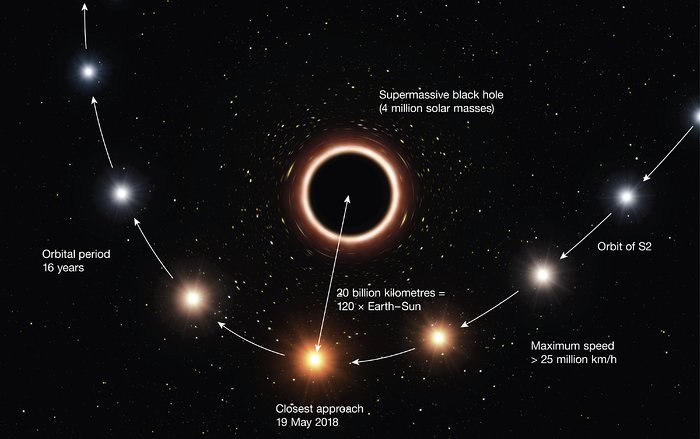The effects predicted by Einstein’s general relativity on the motion of a star passing through the extreme gravitational field have been validated near the supermassive black hole in the center of the Milky Way.
Obscured by thick clouds of absorbing dust, the closest supermassive black hole to the Earth lies 26 000 light-years away at the centre of the Milky Way. This gravitational monster, which has a mass four million times that of the Sun, is surrounded by a small group of stars orbiting around it at high speed. This extreme environment — the strongest gravitational field in our galaxy — makes it the perfect place to explore gravitational physics, and particularly to test Einstein’s general theory of relativity.
New infrared observations from the GRAVITY, SINFONI and NACO instruments on ESO’s Very Large Telescope (VLT) have now allowed astronomers to follow one of these stars, called S2, as it passed very close to the black hole during May 2018. At the closest point this star was at a distance of less than 20 billion kilometers from the black hole and moving at a speed in excess of 25 million kilometers per hour — almost three percent of the speed of light.
The team compared the position and velocity measurements from GRAVITY and SINFONI respectively, along with previous observations of S2 using other instruments, with the predictions of Newtonian gravity, general relativity and other theories of gravity. The new results are inconsistent with Newtonian predictions and in excellent agreement with the predictions of general relativity.

Graphical depiction of the path of the star S2 as it passes very close to the supermassive black hole at the center of the Milky Way. As it gets close to the black hole the very strong gravitational field causes the colour of the star to shift slightly to the red, an effect of Einstein’s general thery of relativity. The color effect and size of the objects have been exaggerated for clarity. Credit: ESO/M. Kornmesser
This research is in a paper entitled “Detection of the Gravitational Redshift in the Orbit of the Star S2 near the Galactic Centre Massive Black Hole“, by the GRAVITY Collaboration, to appear in the journal Astronomy&Astrophysics.


